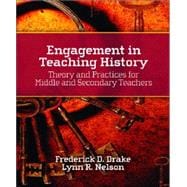
| Theoretical Background | |
| Teaching History | |
| The History of Teaching History | |
| Historical Thinking | |
| Planning And Assessment | |
| Organizing Your History Courses: Making Content Choices | |
| Lesson and Unit Planning | |
| Creating Historical Understanding and Communication through Performance Assessment. | |
| Instruction. | |
| Using Primary Sources: The First-, Second-, and Third-Order Approach | |
| Considering and Doing Discussion in History Teaching | |
| Using Historical Images to Engage Your Students in the Past | |
| Using Writing to Engage Your Students in the Past | |
| Conclusion | |
| Glossary | |
| Index | |
| Table of Contents provided by Publisher. All Rights Reserved. |
The New copy of this book will include any supplemental materials advertised. Please check the title of the book to determine if it should include any access cards, study guides, lab manuals, CDs, etc.
The Used, Rental and eBook copies of this book are not guaranteed to include any supplemental materials. Typically, only the book itself is included. This is true even if the title states it includes any access cards, study guides, lab manuals, CDs, etc.